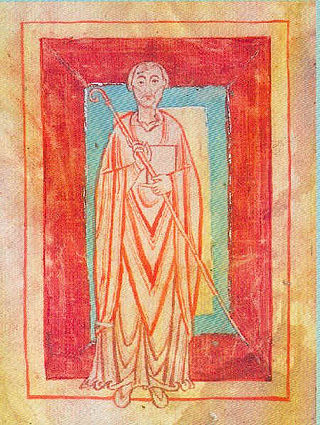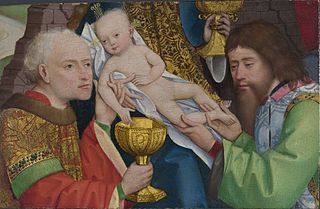
The Benedictines, officially the Order of Saint Benedict, are a mainly contemplative monastic religious order of the Catholic Church for men and for women who follow the Rule of Saint Benedict. The male religious are also sometimes called the Black Monks, in reference to the colour of their religious habits, in contrast to other Benedictine orders such as the Olivetans, who wear white. They were founded in 529 by Benedict of Nursia, a 6th-century Italian monk who laid the foundations of Benedictine monasticism through the formulation of his Rule. Benedict's sister, Scholastica, possibly his twin, also became a religious from an early age, but chose to live as a hermit. They retained a close relationship until her death.

Ulrich of Augsburg, sometimes spelled Uodalric or Odalrici, was Prince-Bishop of Augsburg in the Holy Roman Empire. He was the first saint to be canonized not by a local authority but by the pope.

A scribe is a person who serves as a professional copyist, especially one who made copies of manuscripts before the invention of automatic printing.

Dom Bernard de Montfaucon, O.S.B. was a French Benedictine monk of the Congregation of Saint Maur. He was an astute scholar who founded the discipline of palaeography, as well as being an editor of works of the Fathers of the Church. He is regarded as one of the founders of the modern discipline of archaeology.
Luc d'Achery was a learned French Benedictine of the Congregation of St. Maur, a specialist in the study and publication of medieval manuscripts.
Gregor Zallwein was an Austrian expert on canon law.

Lorsch Abbey, otherwise the Imperial Abbey of Lorsch, is a former Imperial abbey in Lorsch, Germany, about 10 km (6.2 mi) east of Worms. It was one of the most important monasteries of the Carolingian Empire. Even in its ruined state, its remains are among the most important pre-Romanesque–Carolingian style buildings in Germany.

Stephen Harding was an English-born monk and abbot, who was one of the founders of the Cistercian Order. He is honoured as a saint in the Catholic Church.

William of Hirsau was a Benedictine abbot and monastic reformer. He was abbot of Hirsau Abbey, for whom he created the Constitutiones Hirsaugienses, based on the uses of Cluny, and was the father of the Hirsau Reforms, which influenced many Benedictine monasteries in Germany. He supported the papacy in the Investiture Controversy. In the Roman Catholic Church, he is a Blessed, the second of three steps toward recognition as a saint.

Tegernsee Abbey is a former Benedictine monastery in the town and district of Tegernsee in Bavaria. Both the abbey and the town that grew up around it are named after the Tegernsee, the lake on the shores of which they are located. The name is from the Old High German tegarin seo, meaning great lake.

Wessobrunn Abbey was a Benedictine monastery near Weilheim in Bavaria, Germany.

Ulrich of Zell, also known as Wulderic, sometimes of Cluny or of Regensburg, was a Cluniac reformer of Germany, abbot, founder and saint.

Göttweig Abbey is a Benedictine monastery near Krems in Lower Austria. It was founded in 1083 by Altmann, Bishop of Passau.

Benediktbeuern Abbey is an institute of the Salesians of Don Bosco, originally a monastery of the Benedictine Order, in Benediktbeuern in Bavaria, near the Kochelsee, 64 km south-south-west of Munich. It is the oldest and one of the most beautiful monasteries in Upper Bavaria. It was badly damaged in an extreme weather event in 2023.

Schäftlarn Abbey is a Benedictine monastery on the Isar in Schäftlarn, south of Munich in Bavaria, Germany.

Aulne Abbey was a Cistercian monastery located between Thuin and Landelies on the river Sambre in the Bishopric of Liège, Belgium. It is now a Walloon Heritage Site.

The Master of Liesborn was a Westphalian painter, of the fifteenth century, who remains anonymous.
Jacques Bouillart was a Benedictine monk of the Congregation of St.-Maur.
Henry of Nördlingen was a German Catholic priest from Bavaria, who lived in the 14th century, his date of death being unknown. He was the spiritual adviser of Margaretha Ebner, the mystic nun of Medingen.
Sturm, also called Sturmius or Sturmi, was a disciple of Boniface and founder and first abbot of the Benedictine monastery and abbey of Fulda in 742 or 744. Sturm's tenure as abbot lasted from 747 until 779.
 This article incorporates text from a publication now in the public domain : Herbermann, Charles, ed. (1913). "Diemoth". Catholic Encyclopedia . New York: Robert Appleton Company.
This article incorporates text from a publication now in the public domain : Herbermann, Charles, ed. (1913). "Diemoth". Catholic Encyclopedia . New York: Robert Appleton Company.












